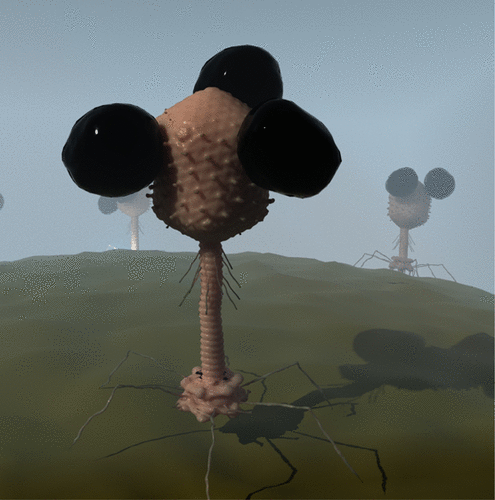当前位置:
X-MOL 学术
›
ACS Appl. Bio Mater.
›
论文详情
Our official English website, www.x-mol.net, welcomes your
feedback! (Note: you will need to create a separate account there.)
Engineering Biorthogonal Phage-Based Nanobots for Ultrasensitive, In Situ Bacteria Detection
ACS Applied Bio Materials ( IF 4.6 ) Pub Date : 2020-06-23 , DOI: 10.1021/acsabm.0c00546 Hannah S Zurier 1 , Michelle M Duong 1 , Julie M Goddard 1 , Sam R Nugen 1
ACS Applied Bio Materials ( IF 4.6 ) Pub Date : 2020-06-23 , DOI: 10.1021/acsabm.0c00546 Hannah S Zurier 1 , Michelle M Duong 1 , Julie M Goddard 1 , Sam R Nugen 1
Affiliation

|
Advances in synthetic biology, nanotechnology, and genetic engineering are allowing parallel advances in areas such as drug delivery and rapid diagnostics. Although our current visions of nanobots may be far off, a generation of nanobots synthesized by engineering viruses is approaching. Such tools can be used to solve complex problems where current methods do not meet current demands. Assuring safe drinking water is crucial for minimizing the spread of waterborne illnesses. Although extremely low levels of fecal contamination in drinking water are sufficient to cause a public health risk, it remains challenging to rapidly detect Escherichia coli, the standard fecal indicator organism. Current methods sensitive enough to meet regulatory standards suffer from either prohibitively long incubation times or requirement of expensive, impractical equipment. Bacteriophages, tuned by billions of years of evolution to bind viable bacteria and readily engineered to produce custom proteins, are uniquely suited to bacterial detection. We have developed a biosensor platform based on magnetized phages encoding luminescent reporter enzymes. This system utilizes bio-orthogonally functionalized phages to enable site-specific conjugation to magnetic nanoparticles. The resulting phage-based nanobots, when combined with standard, portable field equipment, allow for detection of <10 cfu/100 mL of viable E. coli within 7 h, faster than any methods published to date.
中文翻译:

用于超灵敏原位细菌检测的工程双正交噬菌体纳米机器人
合成生物学、纳米技术和基因工程的进步使药物输送和快速诊断等领域取得了平行进展。尽管我们目前对纳米机器人的设想可能还很遥远,但由工程病毒合成的一代纳米机器人正在接近。此类工具可用于解决当前方法无法满足当前需求的复杂问题。确保安全的饮用水对于最大程度地减少水传播疾病的传播至关重要。尽管饮用水中极低水平的粪便污染足以造成公共卫生风险,但快速检测大肠杆菌仍然具有挑战性,标准的粪便指示生物。目前的方法足够敏感以满足监管标准,要么孵化时间过长,要么需要昂贵、不切实际的设备。噬菌体经过数十亿年的进化调整以结合活细菌并易于设计以产生定制蛋白质,特别适合细菌检测。我们开发了一种基于编码发光报告酶的磁化噬菌体的生物传感器平台。该系统利用生物正交功能化的噬菌体来实现与磁性纳米粒子的位点特异性结合。由此产生的基于噬菌体的纳米机器人与标准的便携式现场设备相结合,可以在 7 小时内检测 <10 cfu/100 mL 的活大肠杆菌,比迄今为止发布的任何方法都快。
更新日期:2020-06-23
中文翻译:

用于超灵敏原位细菌检测的工程双正交噬菌体纳米机器人
合成生物学、纳米技术和基因工程的进步使药物输送和快速诊断等领域取得了平行进展。尽管我们目前对纳米机器人的设想可能还很遥远,但由工程病毒合成的一代纳米机器人正在接近。此类工具可用于解决当前方法无法满足当前需求的复杂问题。确保安全的饮用水对于最大程度地减少水传播疾病的传播至关重要。尽管饮用水中极低水平的粪便污染足以造成公共卫生风险,但快速检测大肠杆菌仍然具有挑战性,标准的粪便指示生物。目前的方法足够敏感以满足监管标准,要么孵化时间过长,要么需要昂贵、不切实际的设备。噬菌体经过数十亿年的进化调整以结合活细菌并易于设计以产生定制蛋白质,特别适合细菌检测。我们开发了一种基于编码发光报告酶的磁化噬菌体的生物传感器平台。该系统利用生物正交功能化的噬菌体来实现与磁性纳米粒子的位点特异性结合。由此产生的基于噬菌体的纳米机器人与标准的便携式现场设备相结合,可以在 7 小时内检测 <10 cfu/100 mL 的活大肠杆菌,比迄今为止发布的任何方法都快。











































 京公网安备 11010802027423号
京公网安备 11010802027423号